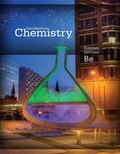
Concept explainers
(a)
Interpretation:
To write the balanced equation of beta decay of the given nuclide 136 5 3 I.
Concept Introduction:
The radioactive decay is the decay of the alpha, beta emission etc. The decay of these type of particles produces the stable nucleus. The nuclear transformation is the chain reaction.
Chain reaction means the reaction proceed in continuity till it will form the stable nucleus.
Beta decay is the decay in which
(b)
Interpretation:
To write the balanced equation of beta decay of the given nuclide 133 5 1 Sb.
Concept Introduction:
The radioactive decay is the decay of the alpha, beta emission etc. The decay of these type of particles produces the stable nucleus. The nuclear transformation is the chain reaction.
Chain reaction means the reaction proceed in continuity till it will form the stable nucleus.
Beta decay is the decay in which atomic number increases by 1 and no change in the mass number.
(c)
Interpretation:
To write the balanced equation of beta decay of the given nuclide 117 4 9 In.
Concept Introduction:
The radioactive decay is the decay of the alpha, beta emission etc. The decay of these type of particles produces the stable nucleus. The nuclear transformation is the chain reaction.
Chain reaction means the reaction proceed in continuity till it will form the stable nucleus.
Beta decay is the decay in which atomic number increases by 1 and no change in the mass number.
Trending nowThis is a popular solution!

Chapter 19 Solutions
EBK INTRODUCTORY CHEMISTRY
 Chemistry: Principles and PracticeChemistryISBN:9780534420123Author:Daniel L. Reger, Scott R. Goode, David W. Ball, Edward MercerPublisher:Cengage Learning
Chemistry: Principles and PracticeChemistryISBN:9780534420123Author:Daniel L. Reger, Scott R. Goode, David W. Ball, Edward MercerPublisher:Cengage Learning Chemistry: The Molecular ScienceChemistryISBN:9781285199047Author:John W. Moore, Conrad L. StanitskiPublisher:Cengage Learning
Chemistry: The Molecular ScienceChemistryISBN:9781285199047Author:John W. Moore, Conrad L. StanitskiPublisher:Cengage Learning Chemistry by OpenStax (2015-05-04)ChemistryISBN:9781938168390Author:Klaus Theopold, Richard H Langley, Paul Flowers, William R. Robinson, Mark BlaserPublisher:OpenStax
Chemistry by OpenStax (2015-05-04)ChemistryISBN:9781938168390Author:Klaus Theopold, Richard H Langley, Paul Flowers, William R. Robinson, Mark BlaserPublisher:OpenStax General, Organic, and Biological ChemistryChemistryISBN:9781285853918Author:H. Stephen StokerPublisher:Cengage Learning
General, Organic, and Biological ChemistryChemistryISBN:9781285853918Author:H. Stephen StokerPublisher:Cengage Learning Chemistry & Chemical ReactivityChemistryISBN:9781133949640Author:John C. Kotz, Paul M. Treichel, John Townsend, David TreichelPublisher:Cengage LearningChemistry: Matter and ChangeChemistryISBN:9780078746376Author:Dinah Zike, Laurel Dingrando, Nicholas Hainen, Cheryl WistromPublisher:Glencoe/McGraw-Hill School Pub Co
Chemistry & Chemical ReactivityChemistryISBN:9781133949640Author:John C. Kotz, Paul M. Treichel, John Townsend, David TreichelPublisher:Cengage LearningChemistry: Matter and ChangeChemistryISBN:9780078746376Author:Dinah Zike, Laurel Dingrando, Nicholas Hainen, Cheryl WistromPublisher:Glencoe/McGraw-Hill School Pub Co





